|
"The Boy at the Battle of Gettysburg"
| Daniel A. Skelly, 1863 |
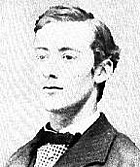
|
| Boy of Gettysburg |
THE BOY OF GETTYSBURG
Daniel Skelly was a Gettysburg teenager in 1863, employed as a clerk at a Gettysburg dry goods company.
His experiences during the three days of the Battle of Gettysburg were exciting and unique. After retirement, Skelly wrote
about his experiences as a young boy in a town filled with the sights and sounds of a war which, up to this point, had been
very far away. He saw and met several famous people during the three days of battle, spoke with Confederate soldiers camped
on the streets outside of his home, and afterward helped aid the wounded that filled the homes and churches in town. Published
in 1932, A Boy's Experiences During The Battle of Gettysburg, is one of the more outstanding civilian accounts of the
battle, from the perspective of an old gentleman who witnessed the true nature of war with its devastation and heartache,
for the first time in his home town.
"The month of June, 1863, was an exciting one for the people of Gettysburg
and vicinity. Rumors of the invasion of Pennsylvania by the Confederate army were rife and toward the latter part of the month
there was the daily sight of people from along the border of Maryland passing through the town with horses and cattle, to
places of safety. Most of the merchants of the town shipped their goods to Philadelphia for safety, as was their habit all
through the war upon rumors of the Confederates crossing the Potomac. The merchandising firm in whose employ I had been for
a number of years (Fahnestock Brothers) kept a car chartered and whenever these rumors reached us, day or night, we packed
up the goods and sent it to Philadelphia and went out of business for the time being, until matters became settled again along
the border, when the stock was brought back and we resumed our routine.
"I was absent from Gettysburg… from the beginning of June until the
latter part of the month. I reached Hanover, Pa., on the afternoon of (June 26), expecting to get a train for home from there
the same evening. But about 5 o'clock the last train out of Gettysburg, until after the battle, reached Hanover filled with
people getting away from the Confederates. They included revenue officers and clerks, in fact all persons who had any office
under the government.
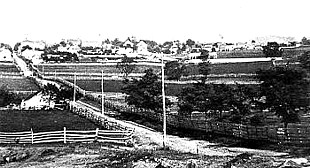
|
| (National Archives) |
(Left) Picture of the town of Gettysburg in 1863. West Middle Street
runs through the center of this photograph. The county courthouse is in the left distance on the skyline.
"Early's Division had occupied Gettysburg that day and made demands upon the
town which were not complied with. Consequently I was obliged to remain in Hanover all night. On the morning of June 27 White's
Confederate cavalry passed through Hanover and remained long enough to get some packages from the express office, one of which
was for my firm and which I saw them open. It contained gloves. They appropriated them. They also captured a jeweler with
his stock loaded in a wagon, who was a little late in getting started out of town, and appropriated his stock also. On the
afternoon of this day, Thaddeus Slentz, Edward Craver and myself secured a hand-car and started for Gettysburg on the Gettysburg
and Hanover railroad, but when we reached New Oxford we found the bridge over the Conewago Creek had been burned. So we were
obliged to abandon the car and walk the remaining ten miles to Gettysburg, reaching there about 5 P.M.
"The 28th and 29th were exciting days in Gettysburg
for we knew the Confederate army, or a part of it at least, was within a few miles of our town and at night we could see from
the house-tops the campfires in the mountains eight miles west of us. We expected it to march into our town at any moment
and we had no information as to the whereabouts of the Army of the Potomac. We little dreamed of the momentous events which
were soon to happen right in our midst.
| Buford |

|
| (USMHI) |
On June 30th two brigades of General Buford's division of cavalry reached our town, coming in
from the south and I well remember how secure this made us feel. We thought surely now we were safe and the Confederate army
would never reach Gettysburg. On the afternoon of this day about 4 o'clock, I stood on the Cobean corner on Chambersburg Street…
while General Buford sat on his horse in the street in front of me, entirely alone, facing to the west in profound thought.
I remember this incident very distinctly for it made a deep impression on (me). It was the only time I ever saw the general
and his calm demeanor and soldierly appearance, as well as the fact that his uniform was different from any general's I had
ever seen. He wore a sort of hunting coat of blouse effect. On the night of the 30th, the people of Gettysburg
settled down in their homes with a sense of security they had not enjoyed for days and with little thought of what the morrow
had in store for them.
"On the morning of July 1, about 8 o'clock, in company of my old friend Samuel
W. Anderson… I walked out the Mummasburg Road north of the town just a short distance beyond the college building, where
lay encamped in the fields, Col. Deven's Brigade of Buford's Division… which with Gamble's Brigade of the same division
had come into our town on the previous day. While we stood at Col. Deven's tent an order was handed him… directing him
to move his brigade west of the town, as the Confederates were then advancing on the town by the Chambersburg Pike. My companion
and I went directly across the fields to Seminary Ridge, then known as the Railroad Woods by reason of the 'Old Tape-worm
Railroad' being cut through it. Anderson went toward the Theological Seminary buildings expecting to get (to) the cupola of
the building. I remained on Seminary Ridge just where the old… railroad cut through it. The ridge was full of men and
boys from town, all eager to witness a brush with the Confederates and not dreaming of the terrible conflict that was to occur
on that day and not having the slightest conception of the proximity of the two armies.
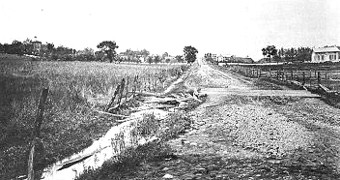
|
| (National Archives) |
(Left) Photograph of Seminary Ridge and the Chambersburg Road in 1863.
It was near the Lutheran Seminary
building at left that Skelly perched himself in a large oak tree to watch the battle west of town.
"I climbed up a good-sized oak tree so as to have a good view of the ridge west and northwest of us, where
the two brigades of cavalry were then being placed. We could then hear distinctly the skirmish fire in the vicinity of Marsh
Creek, about three miles from our position and could tell that it was approaching nearer and nearer as our skirmishers fell
back slowly toward the town contesting every inch of ground. We could see clearly on the ridge … the formation of the
line of battle of Buford's Cavalry, which had dismounted, some of the men taking charge of the horses and the others forming
a line of battle, acting as infantry. Nearer and nearer came the skirmish line as it fell back before the advancing Confederates,
until at last the line on the ridge beyond became engaged. Soon the artillery opened fire and shot and shell began to fly
over our heads, one of them passing dangerously near the top of the tree I was on. There was a general stampede toward town
and I quickly slipped down from my perch and joined the retreat to the rear of our gallant men and boys. I started for town
(and) crossed… over a field to the Chambersburg Pike on the east side of Miss Carrie Shead's School and when about the
middle of the field a cannon ball struck the earth about fifteen or twenty feet from me, scattering the ground somewhat about
me and quickening my pace considerably.
"When I reached the pike, there galloped past me a general and his staff,
who upon reaching the top of the ridge, turned into the lane toward the Seminary building. This I have always believed was
General Reynolds coming onto the field and going to the Seminary where he had an interview with General Buford… before
going out where the battle was in progress. The time was about 9 o'clock or near it, and our infantry had not come up yet.
I was not long in reaching town and found the streets full of men, women and children, all under great excitement. Being anxious
to see more of the battle, I concluded I would go up upon the observatory on the store building of the Fahnestock Brothers,
situated on the northwest corner of Baltimore and West Middle Streets, and just across the street from the court house. The
observatory was on the back of the building fronting on West Middle Street and… had a good view of the field where the
battle was then being fought.
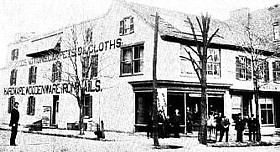
|
| (Tipton Collection, National Archives) |
(Left) Picture of Fahnestock's Store on Baltimore & West Middle Streets,
ca. 1888.
"In company with Mrs. E.G. Fahnestock, wife of Col. Fahnestock, Isaac L.
Johns and Augustus Bentley, I went up through the store to the observatory… (that) had a railing and benches around
it and was about eight feet or more square. We had been up there quite a little time when I observed a general and his staff
coming down Baltimore Street from the south of the town. Upon reaching the court house, they halted and made an attempt to
get up into the belfry to make observations, but they were unable to accomplish this. I went down into the street and going
over to the court house told them that if they wished they could go up on the observatory of the store building. The general
dismounted and with two of his aides went with me up onto the observatory. Upon reaching the house-top, the general, with
his field glasses, made a careful survey of the field west and northwest of the town; also the number of roads radiating like
the spokes of a wheel from the town.
| Gen. Howard |

|
| (Miller's) |
In the midst of it a scout came riding up West Middle Street at a full gallop, halted below us (and) called
up, asking if General Howard (Gen. Oliver Otis Howard, commander of the Eleventh Corps of the Army of the Potomac) were there.
General Howard answering in person, the scout called to him that General Reynolds had been killed and that he should come
onto the field immediately. This scout was George Guinn, a member of Cole's Maryland Cavalry, and was from our county. I knew
him well and recognized him at once. Upon receiving this message the General, his staff officers and myself went down into
the third story ware-room, when General Howard stopped and gave orders to one of his aides to ride back and meet his corps,
which was then on the march from Emmitsburg, Md., ten miles from Gettysburg, and direct General (Adolph von) Steinwehr, upon
reaching the field to occupy Cemetery Hill and fortify it. General Howard, as he came into Gettysburg, had noticed the prominence
of this hill, and riding up to the cemetery was impressed with its commanding position. To his other aide he gave some directions
regarding the bringing up of his corps. One thing which he said that I remember was that the bands should be placed at the
head of the columns and play lively airs as they advanced. General Howard was perfectly calm and self-possessed and I remember
this made a lasting impression on me. And his orders became so fixed on my mind that I have never forgotten them.
"As we passed down through the house, we met Mrs. Samuel Fahnestock,
then an old lady, who was very much agitated. The General stopped and spoke a few kindly words to her, which relieved her
anxiety considerably. He then rode out to the front. After some little time had elapsed we heard a commotion down in the street
(West Middle) and upon looking down saw a column of Confederate prisoners under guard of the Boys in Blue, being conducted
to the rear. It proved to be the Confederate General Archer and several hundred of his brigade who had been captured by the
Iron Brigade. We remained on the house-top until near noon, when it became a little dangerous to stay longer and we went
downstairs again. But shortly after 12 o'clock another officer came along and asked to be taken up where General Howard had
made his observations. He was a captain and belonged to the Eleventh Corps (and) remained only a short time. I learned after
the battle that this officer's name was Frederick Otto Baron Von Fritche, and that he had written a book entitled "A Gallant
Captain of the Civil War", in which he made mention of my taking him up on the roof and giving him some information in regard
to the field and the battle then going on.
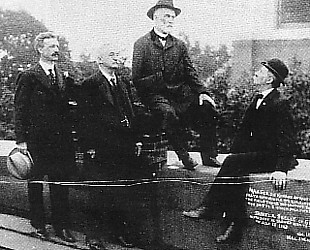
|
| (A Boy's Experiences During The Battle of Gettysburg) |
(About) Photo of the "Returning to Gettysburg" after the Civil War. General Howard paid a visit to
the roof of the Fahnestock Building. The general is in the center of the group, seated on the chimney. Daniel Skelly stands
at left.
"After he had gone I walked down to our Centre Square and there met my mother carrying two buckets of water,
looking for one of the improvised hospitals, to give it to the wounded. It was a striking irony of war that at that time two
of my brothers, members of Company F, 87th Pennsylvania regiment, should be prisoners of war, having been captured
at Winchester, Va., in an engagement while the Confederate army was on its way to Gettysburg. One of them was mortally wounded
and in a southern hospital but a kind Providence withheld this from us until after the battle here. We went down Carlisle
Street to the McCurdy warehouse, just below the railroad, where the wounded were being brought in… No provision had
yet been made for their care in the town and they were laid on the floor. We remained there quite a while giving them water
and doing what we could for their relief.
"I stood on the Cobean corner of Chambersburg Street as Schimmelfenning's
Division of the Eleventh (Corps) passed through town on its way to the front. The day was hot and sultry and they were marching
"quick time", all seeming eager to get to the front. All along Washington Street the people of the town were out with buckets
of water and the soldiers would stop for a moment for a drink and then hurriedly catch up to their place in the line. They
appeared to be straining every effort to reach the scene of conflict, and yet not an hour elapsed before the slightly wounded
were limping back and those badly wounded were being brought back in ambulances to the improvised hospitals in the town. The
hospitals were located in warehouses, churches, the court house and in various private homes. Many others were left dead on
the field they were so heroically eager to reach such a short time before.
"As the afternoon wore away the churches and warehouses on Chambersburg, Carlisle,
and York Streets nearest the line of battle, were filled with wounded. Then the court house, as well as the Catholic, Presbyterian
and Reformed churches and the school house in High Street received the injured soldiers, until those places had reached their
capacity, when private homes were utilized, citizens volunteering to take them in and care for them. In company… with
Miss Julia Culp, a neighbor (who) had a brother in the Confederate Army who was killed on Culp's Hill and a brother in the
Union Army, who survived the war, I went into the court house with buckets of water and passed from one to another of the
wounded relieving them as best we could under the circumstances. Some of them were so frightfully wounded that a lady could
not go near them. These I gave water to, while she cared for those who were not so severely wounded. Quite a number of our
townspeople were there doing everything they could in the relief work as the wounded were carried in.
"When our forces were being driven back through the town in the afternoon,
I went home feeling that everything was lost and throughout my life I have never felt more despondent. One of the regiments
of the Iron Brigade in falling back through town about 4 o'clock in the afternoon passed our house on West Middle Street.
As they turned into (the) street from Washington Street, one of the lieutenants was wounded in the foot but kept up with his
regiment until he reached our house. He was unable to go any further. He came into the yard. Separating the Bowen house next
door and ours, there was an areaway used by both of our families and at the Bowen house was an old-fashioned cellar door standing
open, He took off his sword and pistol and sword belt… hobbled down (the steps) and hid them in the cellar(,) then came
up to get his sword, when the Confederates came into the yard and made him a prisoner, taking his sword away from him. My
mother, standing in our kitchen doorway, seeing he was wounded, asked the Confederates to allow him to come into our house
and she would care for him. They allowed him to come and then continued in pursuit of our retreating forces. My mother took
him into one of the inner rooms and kept him there without the Confederates finding out. After the battle he was taken to
one of the hospitals. In a week or more he was convalescent and came to see is on his way to join his regiment. He sent me
over to the Bowen cellar to get his accoutrements and presented them to me, saying that when he got to Washington he would
get a new outfit. We never heard from him afterwards.
"When I went out in front of the house about 7 o'clock in the evening, the
Confederate line of battle had been formed on East and West Middle Streets, Rodes Division of Ewell's Corps lying right in
front of our house. We were now in the hands of the enemy and in passing, I want to pay a tribute to these veterans of the
Confederate Army. They were under perfect discipline. They were in and about our yard and used our kitchen stove by permission
of my mother... gentlemanly and courteous to us at all times, and I never heard an instance to the contrary in Gettysburg.
We settled down quietly this night. There was no noise or confusion among the Confederate soldiers sleeping on the pavement
below our windows and we all enjoyed a good night's rest after the feverish anxiety of the first day's battle."
"Day dawned on the second of July bright and clear, and we did not know what
to do or expect; whether to remain quietly in our homes, or go out in the town as usual and mingle with our people. But we
were soon assured that if we kept within certain restrictions we could go about the town. It was hot and sultry and the lines
of battle were quiet with the exception of an occasional exchange of shots between pickets or sharpshooters. Some time during
the morning in front of my home on West Middle Street… I was in conversation with one of the Confederate soldiers, whose
regiment lay along the street in line of battle, when he asked me if I had ever seen General Lee. I replied that I had not.
'Well,' he said, 'here he comes up the street on horseback.'
"The general rode quietly by unattended and without any apparent recognition
from the Confederate soldiers along the street. (H)e reached Baltimore Street, about a square away at the court house, (and)
turned into it going up to High Street. I was later informed… that he had gone to the jail, presumably for conference,
but with whom has only been surmise(d). The afternoon… I spent in the yard back of the Fahnestock store on West Middle
Street. There was a high board fence the length of the lot, extending to an alley at the end. There were two large gates opening
to the street along which the Confederate line ran. A Confederate major of one of the regiments was my companion. I do not
remember his name or the regiment to which he belonged, but he told me he was originally from Pittsburgh, going south years
before the war. Our conversation was about the war and the causes leading up to it and the result thus far on both sides.
He was a fair minded man and reasonable in his opinions, there being no rancor or bitterness evident in any of observations
on the progress of the conflict. About 4 o'clock an interruption was caused in our conversation by a terrible cannonading
off to the southwest of town and we separated, he joining his regiment in the street and I going to my father's house near
the Fahnestock store. Our town being in the hands of the Confederates and cut off from all communications with the outside
world, we knew nothing about our army and were completely in the dark as to how it was located and how much of it had arrived
on the field. The Confederates maintained a clam-like silence on all matters concerning the battle, hence we did not know
the significance of this tremendous cannonading until after the battle was over… But for the present it sent everyone
to the cellars as a matter of protection. Mr. Harvey D. Wattles lived close to my father's and under his house was a large
dry cellar. During the cannonading the neighbors congregated in it as a place of safety. My mother and the rest of the family
were there during the afternoon and I was there at intervals while the period of uncertainty caused by this artillery fire
existed. An incident that occurred in this house… will give some idea of what families were exposed to while the fighting
was in progress. A neighbor had come into the house to take refuge and had brought with her a band-box containing a bonnet.
When the cannonading began, she went to the cellar, placing the box on the chair upon which she had been sitting. When she
came from the cellar she found the box where she had left it, but a minie ball had passed through the box and the bonnet.
"About dusk, Will McCreary and I were sent on some errand down on Chambersburg
Street and as we were crossing from Arnold's corner to the present Eckert corner, we were halted by two Confederate soldiers
who had a lady in their charge. She was on horseback and proved to be the wife of General (Francis) Barlow who had come into
the Confederate lines under a flag of truce looking for her husband, who had been severely wounded on July 1, and as she was
informed, had been brought into the town. She informed us he was with a family 'named McCreary' on Chambersburg Street. We
directed her to Smith McCreary's residence (though) she did not find the general there… for he had been taken from the
field to the farmhouse of Josiah Benner on the Harrisburg Road just where the covered bridge crossed the creek. The night
of the second I slept in a room above the Fahnestock store with a number of other boys. Not making any light we would remain
quietly at the window trying to catch the conversation of the Confederate soldiers who were lying on the pavement below the
window. We were eager to catch something that would give us some clue to our army and how they were fairing in the battle…,
but did not learn much from them. We finally went to bed and settled down into a sound sleep as boys do who have few cares
and sound health.
"At intervals during the night I was awakened and could hear the rattle of
musketry fire off to the southeast of town, and it did not seem very far away. When we got up in the morning of the third
of July this firing was a lively as during the night, with the addition of some artillery fire and continued until about 11
o'clock in the morning. About that hour I was down at my father's house and quite a number of Confederate soldiers came into
the yard to the old 'draw well'. They were all begrimed with powder and were 'washing up'. Their remarks about a hill they
were butting up against were neither moral nor complimentary. Of course we were in the dark as to the cause of their discomfiture.
The balance of the morning passed quietly and until about 1:30 P.M. there seemed to be a lull in the activities on the field.
At least it seemed so to us, confined to the limits of the town. About 1:30 however, pandemonium broke loose along the lines
of battle and for one hour there was a din of cannonading, unprecedented on the continent. And then an ominous calm ensued.
What did it mean? We did not know. Nor could we surmise. But I ventured out cautiously from our retreat which was our place
of safety during the cannonading, and walked up to the Fahnestock corner. However I could learn nothing then about the conflict.
"The alleys and street leading up toward the cemetery were barricaded and
the Confederate soldiers behind them in line of battle, were prepared to defend (against) any attack from Cemetery Hill. There
was a long calm, perhaps an hour, when again the artillery opened up from Cemetery Hill, all along the line of battle to the
Round Tops and the rattle of musketry then all over the line except for intervals when great cheers went up from the mighty
hosts of the Boys in Blue. But there were no rebel yells such as we heard from time to time during the three days' battles.
This demonstration occurred, we learned later, when Pickett's charge failed. But we were to remain ignorant of what the great
conflict of the day would bring to us, who were still in the hands of the enemy. On this night, I went to bed restless and
was unable to sleep soundly. About midnight I was awakened by a commotion down in the street. Getting up I went to the window
and saw Confederate officers passing through the lines of Confederate soldiers bivouacked on the pavement below, telling them
to get up quietly and fall back. Very soon the whole line disappeared but we had to remain quietly in our homes for we did
not know what it meant.
"About 4 A.M., there was another commotion in the street, this time on Baltimore,
the Fahnestock building being at the corner of West Middle and Baltimore Streets. It seemed to be a noisy demonstration. Going
hurriedly to the window I looked out. Ye gods! What a welcome sight for the imprisoned people of Gettysburg! The Boys in Blue
marching down the street, fife and drum corps playing, the glorious Stars and Stripes fluttering at the head of the lines.
They picked up the Confederate soldiers who had been left behind in the retreat and were marching them to the rear at double-quick.
It was raining right briskly at this time. I got into my clothes hurriedly and went down o the front door but did not venture
out. As the morning advanced, however, we went about the town mingling with our people, comparing notes and finding out how
all had fared during the days we were in the hands of the enemy.
"We soon learned that part of the town was still not free from 'Our friends-
the enemy'. They had thrown up formidable breastworks extending from the Railroad Woods clear out along the ridge to Emmitsburg
Road and beyond it and they were occupied by Confederate soldiers to protect the retreat of their army. As my father's house
was on West Middle Street, which extends in a direct line out to Haupt's Hill, which was along the embattled ridge, we were
exposed during the whole day to sharpshooters' fire. The Confederates had built little works of stone and ground, just large
enough to cover their heads and protect their bodies, extending down the hill in the direction of town. And they lay behind
them all day with guns loaded ready to bang away at any suspicious object in the street. Sometime during the morning, several
of our officers rode down the street and when about half the length of the square from Baltimore and Washington Street, one
of them was hit in the fleshy part of his army by a bullet, evidently causing a very painful wound, for he yelled at the top
of his voice.
"On this morning, the 5th, my friend 'Gus' Bentley met me on the
street and told me that down at the Hollinger warehouse where he was employed they had a lot of tobacco. 'We hid it away before
the Rebs came into town,' he continued, 'and they did not find it. We can buy it and take it out and sell it to the soldiers.'
Like all boys of those days we had little spending money but we concluded we would try and raise the cash in some way. I went
to my mother and consulted her about it and she loaned me ten dollars. Gus also got ten, all of which we invested in the tobacco.
It was in large plugs- Congress tobacco, a well known brand at that time. With an old-fashioned tobacco cutter we cut it up
into ten cent pieces and each of us took a basket full and started out Baltimore Street to the cemetery, the nearest line
of battle. Reaching the Citizens Cemetery we found a battery of artillery posted there… The soldiers stopped us and
would not let us pass, their orders being not to let anyone out of the town. We went back into the town as far as the Presbyterian
church and went up High Street to the jail, where we turned into a path leading down to the old Rock Creek 'swimmin' hole'.
On the first ridge we saw the first dead Confederate soldiers lying right on the path, two of them side by side, and they
were buried there afterward until the Confederate bodies were taken up years later and shipped to Richmond for burial. We
kept to the path down to the spring (,) then turned over towards Culp's Hill, ascending it at one of its steepest points.
There were all kinds of debris of the battle scattered over the hill, but no dead or wounded soldiers, they having already
been removed.
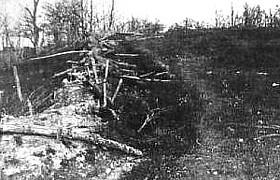
|
| (Tipton Collection, National Archives) |
(Left) Photograph of breastworks near the summit of Culp's Hill where Skelly and his companion sold packets
of tobacco to Union soldiers.
"The breastworks were formidable looking, about three feet or more high, built of trees that had been cut
down by the soldiers for the purpose of throwing up these fortifications. A shallow trench was dug in front of the works and
the ground thrown up on it. The soldiers helped us over the breastworks with our baskets and in a short time they were empty
and our pockets filled with ten-cent pieces. The soldiers told us to go home and get some more tobacco, that they would buy
all we could bring out. We made a number of trips, selling out each time, and after disposing of all our supply, and paying
back our borrowed capital, we each had more money than we ever had before in our lives.
"On Monday, July 6, I made my first trip over our line of battle out to the
Round Tops. Fences were all destroyed and the country all open so that we could drive or walk across country instead of having
to take the Emmitsburg or Taneytown Roads. The whole countryside was covered with ruins of the battle. Shot and shell, guns,
pieces of shells and bullets were strewn about the fields in every direction and everything that the carnage of battle could
produce was evident. Ziegler's Grove showed the effects of the Confederate artillery fire. Good-sized trees were knocked off
and splintered in every imaginable way. The bodies of horses that had been killed were lying about.
| Meade's Headquarters, soon after the battle. |
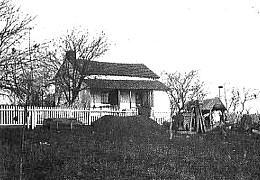
|
| (National Archives) |
The sight around Meade's headquarters along the Taneytown Road was terrible, indicating the exposed position
it occupied, subject to every shot and shell that came over the ridge above it. Around the house and yard and below it lay
at least 12 or 15 dead horses, shot down no doubt while aides and orderlies were delivering orders and messages to headquarters.
A short distance below the house there was a stone fence dividing a field. Across this was hanging a horse which had been
killed evidently just as he was jumping the fence, for its front legs were on one side and the hind legs on the other. In
the road a short distance away was another horse which had been shot down while drawing an ambulance. In the front room of
the house was a bed, the covers of it thrown back; and its condition indicated that a wounded soldier had occupied it. I was
told that General Butterfield, Meade's chief of staff, who had been wounded, had been placed upon it before being taken to
a hospital.
| The Peter Trostle House, July 5-6, 1863. |
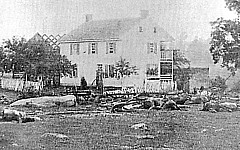
|
| (National Archives) |
"The Trostle house was entirely deserted. In their kitchen the dinner table was still set with all the dishes
from the meal, and fragments of food remained, indicating that the family had gotten up from their meal and made a hurried
getaway. On the Codori farm there were still some dead Confederates who had not been buried. They were lying on their backs,
their faces toward the heavens, and burned as black as coal from exposure to the hot sun. One of the saddest sights of the
day's visit on the field I witnessed near the Devil's Den, on the low ground in that vicinity. There were twenty-six Confederate
officers, ranking from a colonel to lieutenants, laid side by side in a row for burial. At the head of each was a board giving
their names, ranks and commands to which they belonged. A short distance away was another group of thirteen arranged in the
same way. They had evidently been prepared for burial by their Confederate companions before they had fallen back, so that
their identity would be preserved, and they would receive a respectable burial. Among the hundreds of graves on the battlefield
there was but one whose headboard had the Masonic emblems on it. I saw it for the first time this day and often stopped to
look at it afterward. It was close to the southern end of the Codori barn along the Emmitsburg Road (and) was the grave of
a Confederate colonel. (Skelly was later informed that this was the grave of Colonel Joseph Wasden, 22nd Georgia Infantry,
killed on July 2.)
"This, my first sight of a great battlefield, with all its carnage, ruin,
suffering and death- and witnessed the day after the conflict- made a deep and lasting impression on my young mind, stamping
war on my memory as too horrible to even think about.
"During the several days our town was in the hands of the enemy, our wounded
who had been brought in while the first day's battle was in progress and placed in churches, schools, and in many private
homes, were well cared for. The people of the town responded wonderfully in this emergency service. Mothers and daughters
acted as nurses in the hospitals nearest their residences, and also provided all kinds of food and delicacies for the wounded.
In the days following the battle, the firm of Fahnestock Brothers received numerous inquires about wounded soldiers who were
scattered over the field in the hospitals hastily set up at points most conveniently located to take care of the casualties.
With Mrs. E.G. Fahnestock, I frequently rode back and forth among these stations, either in buggy or on horseback, looking
for wounded men about whom information was sought. Sometimes it was difficult to locate them. We made other trips to the hospitals
in the college and seminary buildings also. Frequently on these trips were included supplies of delicacies for the men. So
it was that the people of Gettysburg assisted in every way in solving the problems that arose incident to the great battle.
The months following the conflict found many extra burdens placed on the town, but there was a willing response on the part
of its citizens on all occasions and the confusion that might be expected as an aftermath of such a staggering calamity was
reduced to a minimum."
Daniel Skelly
Gettysburg, Penna., 1932.
Daniel Skelly went on to become a very successful Gettysburg businessman and
member of the local Masonic Lodge. He retired in 1929 from a business career that spanned seventy-two years. Only due to the
persistent encouragement of his children did Skelly complete the story of his experiences, written in 1932. He died later
that year at the age of 87 and is buried in Gettysburg.
Credit: National Park Service, Gettysburg National Military Park
Recommended Reading: Firestorm at Gettysburg:
Civilian Voices (Hardcover). Description: The civilians who lived through the battle of Gettysburg
recount this pivotal event in the American Civil War in their own words. The eyewitness accounts, spanning from June 15, 1863,
through Lincoln’s address in November, are compelling
tales told by those literally trapped inside the lines of the two great, warring armies. Continued below...
Over
160 historical photographs and illustrations accompany the text.
Advance to:
Recommended Reading: The History
Buff's Guide to Gettysburg (Key People, Places, and Events)
(Key People, Places, and Events). Description: While most history books are dry monologues of people, places, events and dates, The History Buff's Guide is ingeniously
written and full of not only first-person accounts but crafty prose. For example, in introducing the major commanders, the
authors basically call Confederate Lt. Gen. Richard S. Ewell a chicken literally. 'Bald, bug-eyed, beak-nosed Dick Stoddard
Ewell had all the aesthetic charm of a flightless foul.' Continued below...
To balance things back out a few pages later, they say
federal Maj. Gen. George Gordon Meade looked like a 'brooding gargoyle with an intense cold stare, an image in perfect step
with his nature.' Although it's called a guide to Gettysburg, in my opinion, it's an authoritative guide to
the Civil War. Any history buff or Civil War enthusiast or even that casual reader should pick it up.
Recommended Reading: Eyewitness
to the Civil War (Hardcover) (416 pages) (National Geographic; Fists edition) (November 21, 2006). Description: At once an informed overview for general-interest readers and a
superb resource for serious buffs, this extraordinary, gloriously illustrated volume is sure to become one of the fundamental
books in any Civil War library. Its features include a dramatic narrative packed with
eyewitness accounts and hundreds of rare photographs, pictures, artifacts, and period illustrations. Evocative sidebars, detailed
maps, and timelines add to the reference-ready quality of the text. Continued below...
From John Brown's
raid to Reconstruction, Eyewitness to the Civil War presents a clear, comprehensive discussion that addresses every military,
political, and social aspect of this crucial period. In-depth descriptions of campaigns and battles in all theaters of war
are accompanied by a thorough evaluation of the nonmilitary elements of the struggle between North and South. In their own
words, commanders and common soldiers in both armies tell of life on the battlefield and behind the lines, while letters from
wives, mothers, and sisters provide a portrait of the home front. More than 375 historical photographs, portraits, and artifacts—many
never before published—evoke the era's flavor; and detailed maps of terrain and troop movements make it easy to follow
the strategies and tactics of Union and Confederate generals as they fought through four harsh years of war. Photoessays on topics
ranging from the everyday lives of soldiers to the dramatic escapades of the cavalry lend a breathtaking you-are-there feeling,
and an inclusive appendix adds even more detail to what is already a magnificently meticulous history.
Recommended
Reading: The Gettysburg Companion: A Guide to the Most Famous
Battle of the Civil War (Hardcover). Description: There
have been many books about Gettysburg, but never one to rival
this in scale or authority. Based on extensive research, The Gettysburg Companion describes the battle in detail, drawing
on firsthand accounts of participants on all sides in order to give the reader a vivid sense of what it was like to experience
the carnage at Gettysburg in early July 1863. The many full-color maps--all specially commissioned for the book--and the numerous
photographs, charts, and diagrams make this book a feast for the eyes and a collector's dream. Includes a massive library
of 500 color illustrations.
Recommended Reading: Gettysburg: A Testing of Courage. Description: America's Civil War raged for more than four years, but it is the three days of fighting in the Pennsylvania countryside in July 1863 that continues to fascinate, appall, and inspire
new generations with its unparalleled saga of sacrifice and courage. From Chancellorsville, where General Robert E. Lee launched
his high-risk campaign into the North, to the Confederates' last daring and ultimately-doomed act, forever known as Pickett's
Charge, the battle of Gettysburg gave the Union army a victory that turned back the boldest and perhaps greatest chance for
a Southern nation.
Continued below...
Now, acclaimed
historian Noah Andre Trudeau brings the most up-to-date research available to a brilliant, sweeping, and comprehensive history
of the battle of Gettysburg that sheds fresh light on virtually every aspect of it. Deftly balancing his own
narrative style with revealing firsthand accounts, Trudeau brings this engrossing human tale to life as never before.
Recommended Reading: General Lee's
Army: From Victory to Collapse (Hardcover). Review: You cannot say that
University of North Carolina
professor Glatthaar (Partners in Command) did not do his homework in this massive examination of the Civil War–era lives
of the men in Robert E. Lee's Army of Northern Virginia. Glatthaar spent nearly 20 years examining and ordering primary source
material to ferret out why Lee's men fought, how they lived during the war, how they came close to winning, and why they lost.
Glatthaar marshals convincing evidence to challenge the often-expressed notion that the war in the South was a rich man's
war and a poor man's fight and that support for slavery was concentrated among the Southern upper class. Continued below...
Lee's army
included the rich, poor and middle-class, according to the author, who contends that there was broad support for the war in
all economic strata of Confederate society. He also challenges the myth that because Union forces outnumbered and materially
outmatched the Confederates, the rebel cause was lost, and articulates Lee and his army's acumen and achievements in the face
of this overwhelming opposition. This well-written work provides much food for thought for all Civil War buffs.
|

